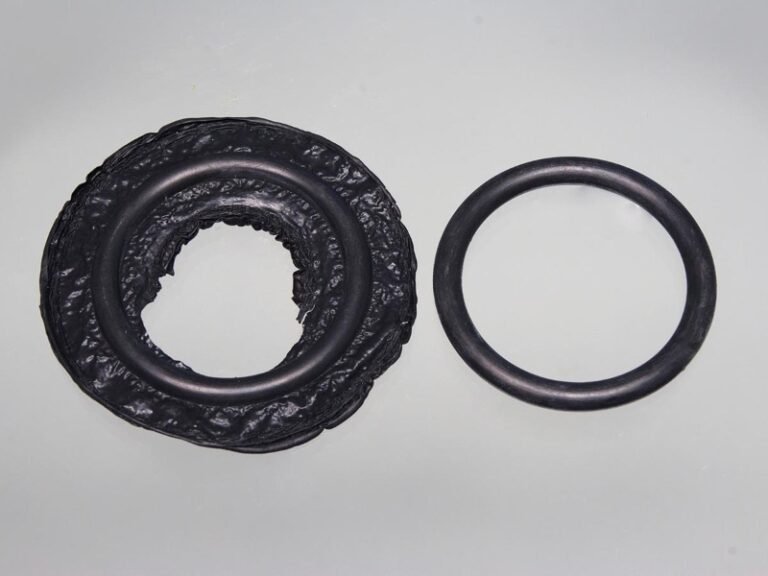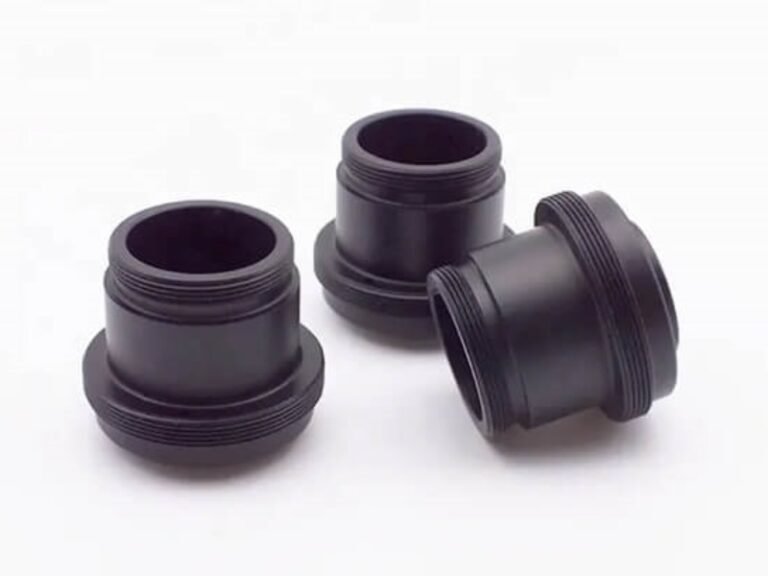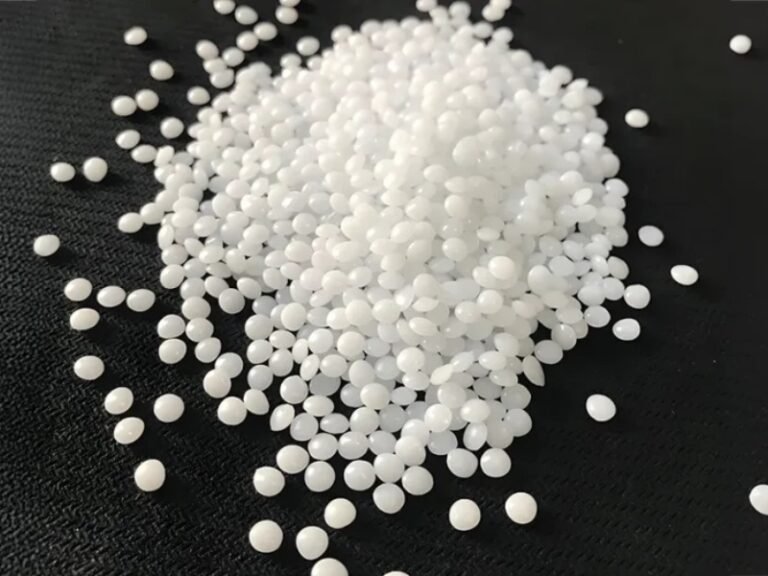HDPE machining has become increasingly important in various industries due to HDPE’s unique combination of strength, chemical resistance, and ease of processing. This article explore HDPEmachining process and tips etc. informtion.
What Is HDPE?
High-Density Polyethylene (HDPE) is a thermoplastic polymer known for its high strength-to-density ratio. Its molecular structure features minimal branching, resulting in strong intermolecular forces that give HDPE superior rigidity, chemical resistance, and impact strength compared to other forms of polyethylene.
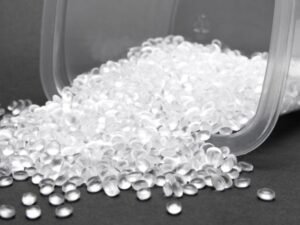
The following table summarizes HDPE’s key properties,
| Property | Value/Description |
|---|---|
| Density | 0.93–0.97 g/cm³ |
| Tensile Strength (Yield) | 23.0–29.5 MPa |
| Tensile Strength (Break) | 30.5–33 MPa |
| Elongation at Break | 100–600% |
| Melting Point | 120–180°C |
| Hardness | Rockwell R65 |
| Chemical Resistance | High (resists acids, bases, solvents) |
| Impact Resistance | Excellent, withstands high physical stress |
| Moisture Absorption | Low, ideal for wet environments |
HDPE vs. Other Thermoplastics
When considering HDPE CNC machining, it’s essential to compare HDPE with other thermoplastics to select the suitable material. The table below compare HDPE with common alternatives:
| Material | Strength-to-Density Ratio | Chemical Resistance | Impact Resistance | Stiffness | Temperature Resistance | Cost |
|---|---|---|---|---|---|---|
| HDPE | High (0.93–0.97 g/cm³) | Excellent | Excellent | Moderate | Low (~120–180°C) | Low |
| LDPE | Lower (0.91–0.94 g/cm³) | Good | Moderate | Low | Low (~100–115°C) | Low |
| PP | Moderate (0.90–0.91 g/cm³) | Good | Moderate | Moderate | Moderate (~130–170°C) | Low |
| ABS | Moderate (1.04–1.06 g/cm³) | Moderate | Good | High | Moderate (~80–100°C) | Moderate |
| PEEK | High (1.32 g/cm³) | Excellent | Good | Very High | High (~250–300°C) | High |
| PTFE | Low (2.1–2.3 g/cm³) | Excellent | Moderate | Low | High (~260°C) | High |
Advantages of Precision HDPE Machining
Compared to HDPE molding, which is best for mass production, HDPE CNC machining offers unique benefits for precision parts, prototypes, and custom applications. It has several advantages, such as:
- High Precision: HDPE CNC machining achieves tight tolerances (as low as ±0.001 inches), enabling the creation of intricate components like gears, fittings, or complex prototypes.
- Cost-Effective Production: The low cost of HDPE raw material, combined with minimal tool wear during machining HDPE, reduces overall expenses.
- Versatile Design Capabilities: HDPE CNC processes a wide range of part geometries and features, such as flat panels, cylindrical rods, holes, slots, and threads.
- Enhanced Durability: HDPE’s superior chemical and impact resistance ensures machined parts withstand harsh environments, such as corrosive chemicals or wet conditions.
- Eco-Friendly Manufacturing: HDPE’s recyclability and efficient material usage minimizes waste.
- Rapid Turnaround Times: CNC machining without molds making and testing, that accelerating production cycles.
- Easy Part Modifications: CNC machining programming can be changed easily. No need to re-make the mold when the part design changes

HDPE CNC Machining
Common CNC Processes for HDPE
If you’re sourcing CNC machining parts in China, understanding the right process is crucial to ensuring quality and cost-effectiveness. HDPE CNC processes include several techniques tailored to its properties:
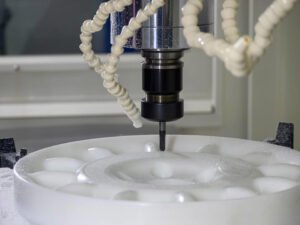
- CNC Milling: This process is the most versatile method for shaping HDPE. Milling employs rotating cutters moving along multiple axes to create complex geometries, such as slots or contours.
- CNC Routing: Primarily used for large flat HDPE sheets, CNC routing is efficient for cutting 2D profiles or shallow 3D shapes.
- CNC Drilling: Utilized for precise hole creation in HDPE parts. It complements milling or routing in CNC machining HDPE for components like containers.
- CNC Turning: Shapes cylindrical parts, such as pipes or bushings, by rotating the workpiece against a cutting tool.
Types of HDPE Material for Machining
HDPE comes in various grades and formulations, each suited for different machining and application needs:
Standard HDPE
Standard HDPE, often referred to as PE300, is the most widely used form in HDPE machining. Its balanced strength-to-density ratio (0.93–0.97 g/cm³) and high impact resistance make it ideal for general-purpose parts like pipes, containers, and consumer goods. Economical and easy to machine or weld, it suits HDPE CNC processes for industrial applications requiring chemical resistance and durability.
HDPE with UV Stabilization
UV-stabilized HDPE incorporates additives to resist degradation from sunlight exposure. This variant excels in outdoor HDPE CNC machining applications, such as playground equipment, piping systems, and outdoor furniture. Its machinability remains consistent with standard HDPE, ensuring precision in CNC machining HDPE.
Cross-Linked HDPE (PEX)
Cross-linked HDPE (PEX) features chemically linked polymer chains, enhancing thermal and chemical resistance. Ideal for machining HDPE in high-demand environments, PEX is used in underfloor heating systems and hot water pipes, where it withstands elevated temperatures (up to 95°C) and stress cracking. Its robust properties support precise HDPE CNC processes.
High-Molecular-Weight HDPE (HMW HDPE)
HMW HDPE, or PE500, boasts a higher molecular weight, offering superior impact strength, toughness and abrasion resistance. This type is perfect for HDPE machining large, durable components like automotive fuel tanks, marine structures, and industrial wear parts.
Ultra-High-Molecular-Weight HDPE (UHMWPE)
UHMWPE, or PE1000, is renowned for its extreme toughness and abrasion resistance due to its long polymer chains. Denser than standard HDPE, it’s ideal for CNC machining HDPE in high-abrasion applications like conveyor belts, gears, lining chutes, and medical implants. Its durability makes it a top choice for precision HDPE CNC processes.
HDPE with Fiber Reinforcement
Fiber-reinforced HDPE, enhanced with carbon or glass fibers, offers superior strength and stiffness. This variant is suited for HDPE machining in structural applications, such as automotive components and construction materials, where enhanced mechanical properties are critical.
Applications of Machined HDPE Components
Machined HDPE parts serve critical roles across diverse industries:

- Home Appliances: Control knobs, housings, brackets.
- Food Industry: FDA-compliant containers, cutting boards, trays.
- Electrical: Cable protectors, insulating components.
- Automotive: Lightweight fuel tanks, protective covers.
- Construction and Infrastructure: Pipes, playground equipment, outdoor furniture.
- Medical Devices: UHMWPE for implants and wear-resistant components.
Expert Tips for HDPE Machining
To optimize HDPE CNC machining, consider these practical tips:
Anneal Workpieces: Heat-treat HDPE to relieve internal stresses, preventing cracks during machining HDPE.
Use Sharp Tools: Carbide or high-speed steel cutters ensure clean cuts, reducing heat buildup and extending tool life.
Optimize Parameters: Set high feed rates (18–22 IPM) and moderate speeds (4500–5000 RPM) to balance efficiency and heat management.
Control Heat: Apply water-soluble coolants or compressed air to dissipate heat, as HDPE’s low melting point (120–180°C) risks deformation.
Secure Workpieces: Use vacuum tables or screws to prevent warping, compensating for HDPE’s thermal expansion.
Test Settings: Start with conservative parameters and adjust based on HDPE grade to achieve optimal surface finishes.
Conclusion
HDPE molding is a more cost-effective option for mass production of standard parts. In contrast, HDPE CNC machining excels at handling small to medium batches and complex geometries. HDPE CNC machining is a versatile, efficient manufacturing approach combining the benefits of HDPE’s material properties with the precision and flexibility of CNC technology. For cost-effective and high-quality CNC machining parts in China, many companies turn to experienced manufacturers who provide precision machining at competitive prices. Zhongde offers expert HDPE CNC solutions delivering tailored components.
FAQ
Yes, machining HDPE supports complex geometries like contoured fittings or slotted panels using HDPE CNC milling and turning.
HDPE’s melting point (120–180°C) limits high-temperature use, but UV-stabilized HDPE resists sunlight degradation for outdoor applications.
Yes, Zhongde provides custom HDPE CNC machining for small-batch and high-volume projects.

